The National Ploughing Championships continues to stand as one of the flagship trade events on the Irish calendar, and this year’s event was no exception. With over 1,700 stands in attendance, the event drew more than 200,000 visitors.
Notably, there was a significant increase in the number of renewable energy companies, particularly solar PV suppliers and anaerobic digestion (AD) companies in attendance, reflecting the current trends in industry.
Interest in solar PV was reported to be at an all-time high. However, most of this interest still came from larger users of energy such as dairy, pig and poultry farmers.
TAMS delays
A recurring theme at the event was the growing frustration among solar PV suppliers and farmers due to delays in processing applications for the Solar Capital Investment Scheme (SCIS).

Minister for Agriculture Charlie McConalogue explained that commercial renewable projects for farmers is the next step for solar PV.
The scheme opened for applications earlier this year and offers up to 60% grant aid to help cover the cost of solar panels for farmers. Despite the Department of Agriculture receiving over 700 applications in the initial tranche, no farmers have received payment yet.
The Department had previously announced that solar applications would be the first to be approved earlier this month.
However, suppliers of solar PV equipment at this year’s event expressed concerns that ongoing delays might lead to panels not being installed until next year.
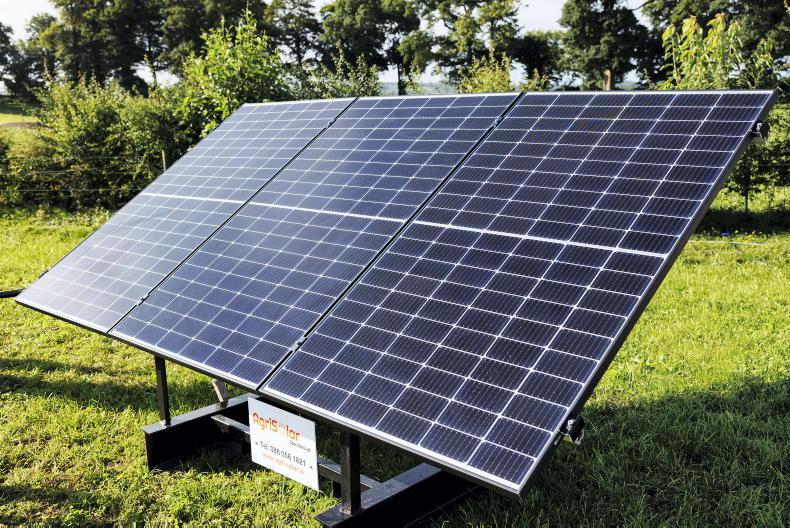
Multiple suppliers of solar panels said that TAMS delays were causing big issues.
During a discussion on the Irish Farmers Journal renewables talk, Darren Buckley, Renewable Energy Director with Alternative Energy Ireland (AEI), stated that farmers applying for the next tranche of the SCIS likely won’t have solar panels on their roofs until the following year.
This delay will extend the payback period for these solar systems as energy prices continue to decrease.
The Department was contacted for a fifth time this week to clarify these issues but at the time of going to print, they had not responded.
Calls for rolling approvals
Steven Bray, the Managing Director of AEI, explained that although interest from farmers has never been higher, delays in processing TAMS grant aid continue to impede projects.
He explained that the TAMS batch processing and approval approach results in a flood of requests from farmers to install panels at the same time once a tranche is approved.
He suggested that the Department should adopt a rolling grant window, where grants are approved on a rolling basis rather than in batches. This would make the process much smoother for both farmers and installers.
Grid Connection
Suppliers also voiced criticism about the sluggish progress in grid connections for larger solar PV systems. Larger systems are required to apply to the ESB for an NC7 grid connection, a process that is currently taking up to 12 months to complete and costing around €1,000.
Commercial project capacity
Ireland’s aging electricity grid and its capacity to support new projects in rural areas are poised to become significant challenges for farmers interested in pursuing new commercial renewable projects.
This was highlighted by Teagasc Bioenergy Specialist Barry Caslin and Pat Smith, Managing Director of Local Power, who spoke on a renewables panel discussion on the Irish Farmers Journal stand at the event.
As new schemes are announced to allow farmers to develop small-scale commercial electricity projects, the grid may not have the capacity to accommodate them all without significant strengthening works.
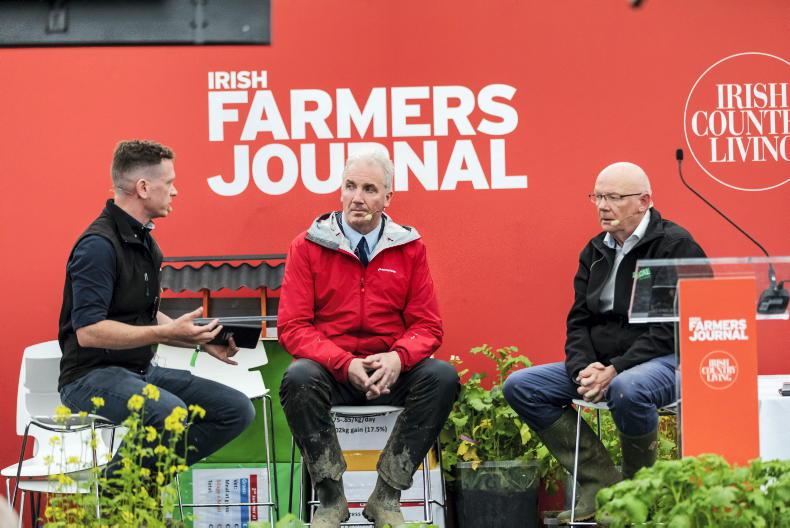
Stephen Robb talking to Teagasc's Barry Caslin and Pat Smith of Local Power at the 2023 National Ploughing Championships.
This means that farmers will be in a race to secure available grid connection capacity in their area or risk not being able to proceed with their planned projects.
Smith emphasised the need for any newly introduced scheme to be accompanied by a policy that guarantees grid connections.
However, Caslin explained that for larger projects up to 6MW, particularly those involving groups of farmers in community projects, the development may be able to justify the cost of upgrading the grid in their area.
Minister McConalogue, speaking on the Irish Farmers Journal stand, explained that the launch of the scheme enabling farmers to invest in commercial renewable projects represents the next phase in the development of solar PV.
The new scheme is scheduled to be launched later this year or in early 2024.
New design of wind turbine
The event marked the Irish debut of the innovative RidgeBlade, a unique wind turbine designed to be placed on the peak of a roof, where airflow is typically three times faster.
As wind travels over the roof’s surface, it’s funnelled into a narrow passage at the roof ridge, causing the air to accelerate as it enters the turbine, generating electricity.
The RidgeBlade can also be installed alongside solar panels in a hybrid system.
AD goes mainstream
This year, possibly for the first time, there were numerous stands representing the AD sector. The AD sector is gaining significant traction, especially with the impending publication of the National Biomethane Strategy.
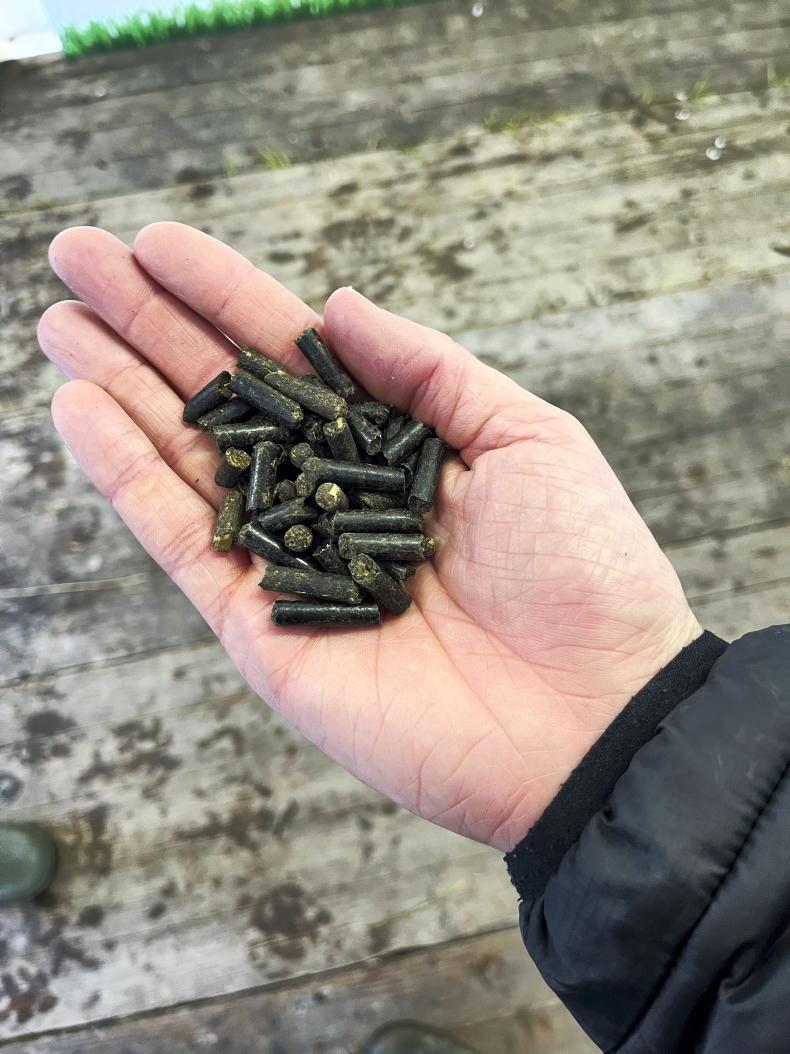
Pelleted digestate was highlighted as a means to help solve dairy farmer's nitrate problems.
Throughout the event, the Irish Farmers Journal hosted speakers from Carbon AMS, Nephin Renewable Gas, and the IFA who shared their insights on the sector’s future.
They all agreed that small, farm projects might face viability challenges, but differed on what scale should be pursued. Paul O’Brien, Chair of the IFA Environmental & Rural Affairs Committee made the point that farmers will likely have a better chance of developing a project if smaller scale plants were viable.
The development of AD was also highlighted as a key tool to help deal with nitrates challenges, with pelleted digestate on display at the event.
Nephin Renewable Gas
The event served as the launch platform for Nephin Renewable Gas, a newly established company owned by Nephin Energy, the largest natural gas producer in Ireland and a shareholder in the Corrib Gas Field.
This company is embarking on an ambitious plan to develop 20-30 AD plants with the aim of producing 1.2-1.5 terrawatt hours of biomethane.
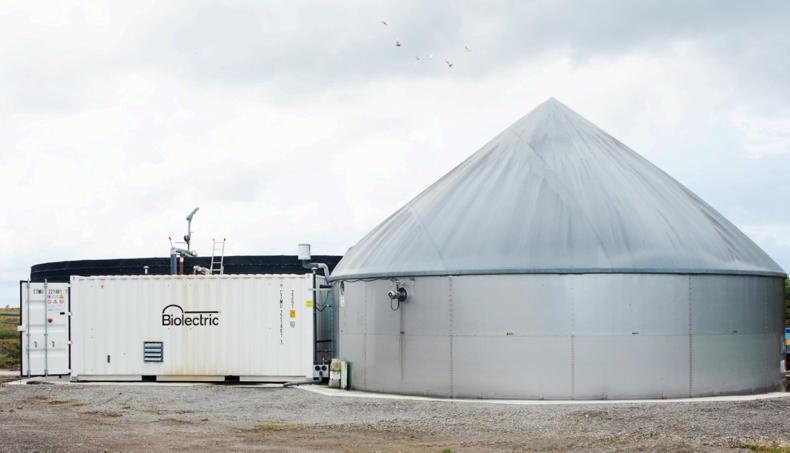
Biolectric showcased their small scale farm AD plant at the show.
This volume would account for approximately 25% of Ireland’s 2030 target for biomethane production.
Nephin Renewable Gas has already secured 10 AD sites, primarily in Munster, and is collaborating with farmers to secure additional locations.
Approximately 80% of the feedstock needed for these plants will be sourced from agricultural inputs, with each plant requiring roughly 3,000 acres of grass silage or whole crop and approximately 40,000 tonnes of slurry.
Around 60% of the primary feedstock for each plant will be supplied by farmers who have committed to 15-year feedstock supply contracts. Each plant is projected to generate around 60 gigawatt-hours (GWh) of biomethane and contribute to the creation of 70 new jobs, both directly and indirectly.
Biolectric
Alpha Energy also had a stand at the event, showcasing the Belgian AD system known as Biolectric. This small-scale on-farm AD plant is designed for farms with more than 100 cows.
The Biolectric AD plant is specifically engineered to convert cow slurry into electricity as opposed to biomethane. As a reference point, the company states that the slurry from 120 cows can produce approximately 22 kW of electricity.
Over the past decade, Biolectric has successfully installed over 300 AD plants across Europe, including three in operation in Northern Ireland.
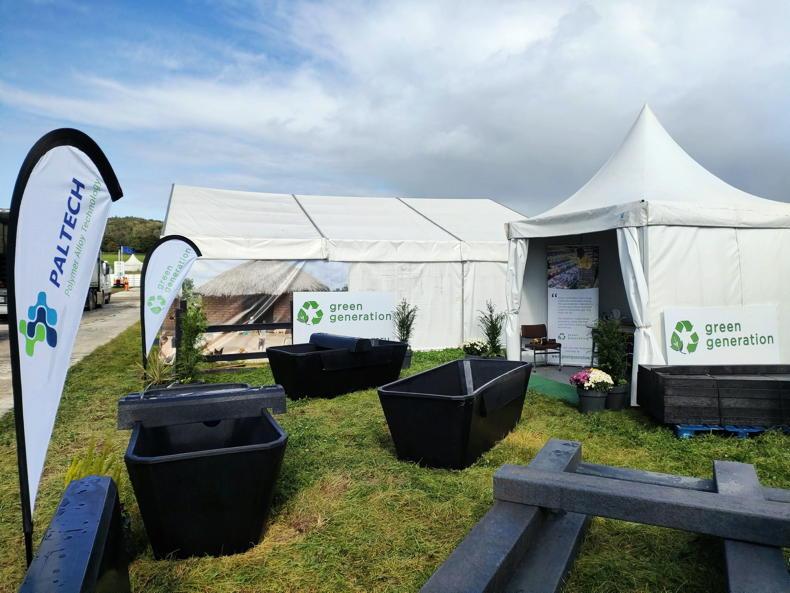
Green Generation were displaying their recycled plastic products at the event.
The entire process, from order placement to delivery, takes approximately four months, and installation on farm can be completed in just two to three days.
Green Generation
Kildare-based food-waste AD plant Green Generation also attended the event. The company showcased a range of fully recycled plastic products, all of which were made from recycled food waste packaging.
The National Ploughing Championships continues to stand as one of the flagship trade events on the Irish calendar, and this year’s event was no exception. With over 1,700 stands in attendance, the event drew more than 200,000 visitors.
Notably, there was a significant increase in the number of renewable energy companies, particularly solar PV suppliers and anaerobic digestion (AD) companies in attendance, reflecting the current trends in industry.
Interest in solar PV was reported to be at an all-time high. However, most of this interest still came from larger users of energy such as dairy, pig and poultry farmers.
TAMS delays
A recurring theme at the event was the growing frustration among solar PV suppliers and farmers due to delays in processing applications for the Solar Capital Investment Scheme (SCIS).

Minister for Agriculture Charlie McConalogue explained that commercial renewable projects for farmers is the next step for solar PV.
The scheme opened for applications earlier this year and offers up to 60% grant aid to help cover the cost of solar panels for farmers. Despite the Department of Agriculture receiving over 700 applications in the initial tranche, no farmers have received payment yet.
The Department had previously announced that solar applications would be the first to be approved earlier this month.
However, suppliers of solar PV equipment at this year’s event expressed concerns that ongoing delays might lead to panels not being installed until next year.

Multiple suppliers of solar panels said that TAMS delays were causing big issues.
During a discussion on the Irish Farmers Journal renewables talk, Darren Buckley, Renewable Energy Director with Alternative Energy Ireland (AEI), stated that farmers applying for the next tranche of the SCIS likely won’t have solar panels on their roofs until the following year.
This delay will extend the payback period for these solar systems as energy prices continue to decrease.
The Department was contacted for a fifth time this week to clarify these issues but at the time of going to print, they had not responded.
Calls for rolling approvals
Steven Bray, the Managing Director of AEI, explained that although interest from farmers has never been higher, delays in processing TAMS grant aid continue to impede projects.
He explained that the TAMS batch processing and approval approach results in a flood of requests from farmers to install panels at the same time once a tranche is approved.
He suggested that the Department should adopt a rolling grant window, where grants are approved on a rolling basis rather than in batches. This would make the process much smoother for both farmers and installers.
Grid Connection
Suppliers also voiced criticism about the sluggish progress in grid connections for larger solar PV systems. Larger systems are required to apply to the ESB for an NC7 grid connection, a process that is currently taking up to 12 months to complete and costing around €1,000.
Commercial project capacity
Ireland’s aging electricity grid and its capacity to support new projects in rural areas are poised to become significant challenges for farmers interested in pursuing new commercial renewable projects.
This was highlighted by Teagasc Bioenergy Specialist Barry Caslin and Pat Smith, Managing Director of Local Power, who spoke on a renewables panel discussion on the Irish Farmers Journal stand at the event.
As new schemes are announced to allow farmers to develop small-scale commercial electricity projects, the grid may not have the capacity to accommodate them all without significant strengthening works.

Stephen Robb talking to Teagasc's Barry Caslin and Pat Smith of Local Power at the 2023 National Ploughing Championships.
This means that farmers will be in a race to secure available grid connection capacity in their area or risk not being able to proceed with their planned projects.
Smith emphasised the need for any newly introduced scheme to be accompanied by a policy that guarantees grid connections.
However, Caslin explained that for larger projects up to 6MW, particularly those involving groups of farmers in community projects, the development may be able to justify the cost of upgrading the grid in their area.
Minister McConalogue, speaking on the Irish Farmers Journal stand, explained that the launch of the scheme enabling farmers to invest in commercial renewable projects represents the next phase in the development of solar PV.
The new scheme is scheduled to be launched later this year or in early 2024.
New design of wind turbine
The event marked the Irish debut of the innovative RidgeBlade, a unique wind turbine designed to be placed on the peak of a roof, where airflow is typically three times faster.
As wind travels over the roof’s surface, it’s funnelled into a narrow passage at the roof ridge, causing the air to accelerate as it enters the turbine, generating electricity.
The RidgeBlade can also be installed alongside solar panels in a hybrid system.
AD goes mainstream
This year, possibly for the first time, there were numerous stands representing the AD sector. The AD sector is gaining significant traction, especially with the impending publication of the National Biomethane Strategy.

Pelleted digestate was highlighted as a means to help solve dairy farmer's nitrate problems.
Throughout the event, the Irish Farmers Journal hosted speakers from Carbon AMS, Nephin Renewable Gas, and the IFA who shared their insights on the sector’s future.
They all agreed that small, farm projects might face viability challenges, but differed on what scale should be pursued. Paul O’Brien, Chair of the IFA Environmental & Rural Affairs Committee made the point that farmers will likely have a better chance of developing a project if smaller scale plants were viable.
The development of AD was also highlighted as a key tool to help deal with nitrates challenges, with pelleted digestate on display at the event.
Nephin Renewable Gas
The event served as the launch platform for Nephin Renewable Gas, a newly established company owned by Nephin Energy, the largest natural gas producer in Ireland and a shareholder in the Corrib Gas Field.
This company is embarking on an ambitious plan to develop 20-30 AD plants with the aim of producing 1.2-1.5 terrawatt hours of biomethane.

Biolectric showcased their small scale farm AD plant at the show.
This volume would account for approximately 25% of Ireland’s 2030 target for biomethane production.
Nephin Renewable Gas has already secured 10 AD sites, primarily in Munster, and is collaborating with farmers to secure additional locations.
Approximately 80% of the feedstock needed for these plants will be sourced from agricultural inputs, with each plant requiring roughly 3,000 acres of grass silage or whole crop and approximately 40,000 tonnes of slurry.
Around 60% of the primary feedstock for each plant will be supplied by farmers who have committed to 15-year feedstock supply contracts. Each plant is projected to generate around 60 gigawatt-hours (GWh) of biomethane and contribute to the creation of 70 new jobs, both directly and indirectly.
Biolectric
Alpha Energy also had a stand at the event, showcasing the Belgian AD system known as Biolectric. This small-scale on-farm AD plant is designed for farms with more than 100 cows.
The Biolectric AD plant is specifically engineered to convert cow slurry into electricity as opposed to biomethane. As a reference point, the company states that the slurry from 120 cows can produce approximately 22 kW of electricity.
Over the past decade, Biolectric has successfully installed over 300 AD plants across Europe, including three in operation in Northern Ireland.

Green Generation were displaying their recycled plastic products at the event.
The entire process, from order placement to delivery, takes approximately four months, and installation on farm can be completed in just two to three days.
Green Generation
Kildare-based food-waste AD plant Green Generation also attended the event. The company showcased a range of fully recycled plastic products, all of which were made from recycled food waste packaging.












 This is a subscriber-only article
This is a subscriber-only article










SHARING OPTIONS: